






If you have served in the military for any number of years, this is likely the first time since high school you have had to think about what goes into finding a job. And depending on when you entered the service, some things about the hunt have probably changed — like the part where most companies have an online application process.
The recent push in years to highlight the value of applicants with military service has been effective as the veteran unemployment rate is currently at

3.7%, according to the Department of Labor. It is estimated that 230,000 to 245,000 enlisted service members and officers will separate from the military this year, which means you will be competing against your peers for a next career. The question becomes, how do you stand out among a sea of job seekers who also tout “military” on their resume? Some of the answers lie within the pages of this resource guide.
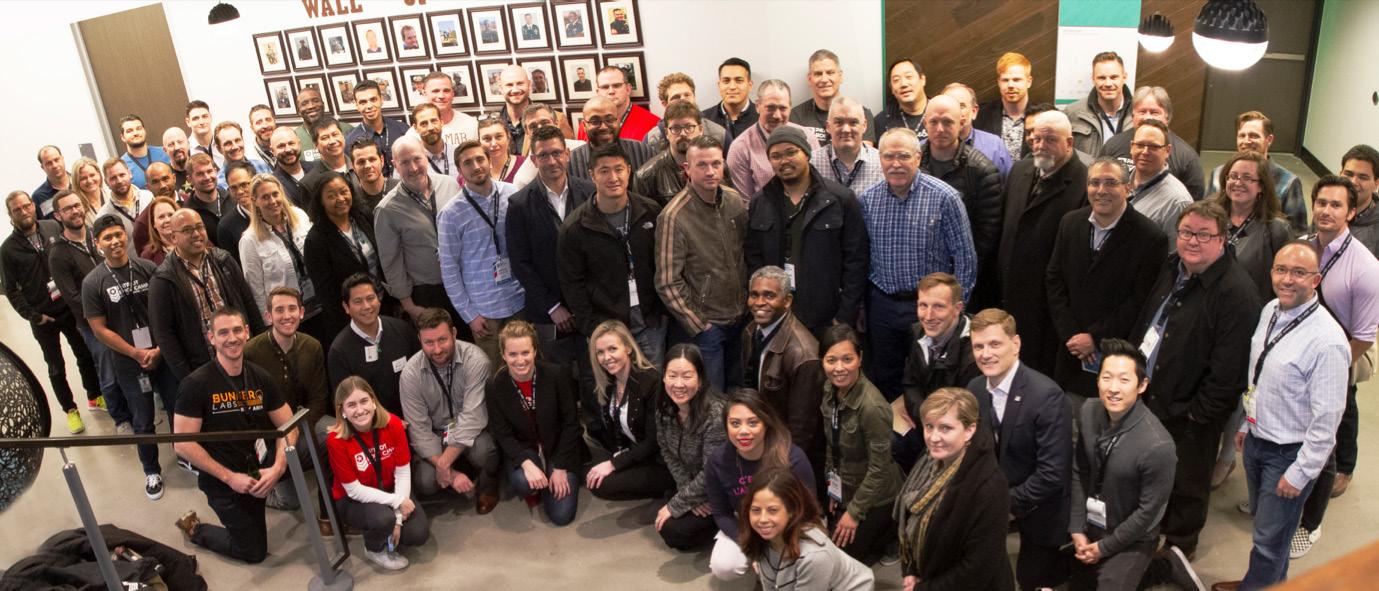
Among the top challenges we hear from those navigating the postmilitary transition are:
• Translating what they did in the military effectively,
• Crafting a resume that catches the attention of hiring managers, and
• Finding purpose after doing a job filled with core values, which is why many choose to work for themselves.
In addition to including over 24
organizations currently offering free employment resources — like resume building, interview preparation and employer connections — we also focused on the latest trend within the veteran community: entrepreneurship. In fact, a recent Small Business Administration survey found that veterans are 45% more likely to be self-employed than non-veterans. You will read the stories of Post-9/11 veterans who launched ventures that also fill a void left behind from the military.
No matter what phase you stand in of the transition process, there are programs and resources to simplify the process. You’ve served your country, now find the companies that value the unique attributes that stem from military service.
Yours in reading,
 Bianca M. Strzalkowski
Bianca M. Strzalkowski
Except for a stint at a burger joint as a teenager, Capt. Patricia Cole transitioned from the military after a full career with the United States Navy, and, like any other life change, it was scary and nerve-racking. Cole is now the program director of career transition services at Military Officers Association of America , and believes the anticipation of transition is far worse than the experience itself.
According to Cole, less than 5% of Americans have served in the Armed Forces.
“Veterans quake at the thought of translating their military skills and experience into terms a civilian can understand, but I don’t think it’s as hard as veterans fear,” she said.
Megan Spittler separated from the Navy in 2015 after serving more
than eight years. In addition to participating in the Transition Assistance Program — a program focused on providing separating service members with information, tools and services for life after the military, she also used a job hunter she found on LinkedIn to help her prepare for interviews.
“I accepted a job offer while I was still on terminal leave. I feel very lucky because my transition was easy,” she said.
Jen St. Pierre, a career services and transition specialist at Wounded Warrior Project , knows the ins and outs of effective job search strategies, and military to civilian resume optimization.
“Every warrior is different and has distinct skills,” she said. St. Pierre shares a few tips to ease the transition from military to civilian life:
Jim Brooks, a recently retired Lt. Cmdr. who served 21 years in the Navy, worked as a contractor for a few months before leaving to teach middle school for a year.
“I am going into the job market again after this year in teaching, and frankly I still feel lost. Other than a lot of leadership and management stuff, I do not have a lot of directly translating skills,” Brooks said. “And I really don’t want to manage a bunch of people anymore.”
St. Pierre encourages service members to think outside the box.
“Do they volunteer? What are their interests? How do these other things influence which job they might want to pursue? These are all things to consider before building a resume,” she said.

“Evaluations, fit reps and/or awards with descriptions,” St. Pierre said. “These are the foundation for a resume.”
Service members should also refer to their Verification of Military and Employment Training, which is a document every service member can request when he or she separates.
“VMET is your military resume. It keeps track of schools, specialized training and ranks , ” St. Pierre clarified.
A resume may be dismissed if the recruiter doesn’t understand the terminology. For example, if a service member was responsible for weapons, St. Pierre suggests translating this skill to safety and security. Translation of rank is also necessary.
“Leadership ranks are equivalent to director or supervisor,” she said. “ Take titles and civilianize them.”
“Action verbs is an effective way to make a resume stand out,” St. Pierre said.
Abbreviate contact information. “Skip the address,” she advise d . “Include a cell number and live links to both your email and LinkedIn profile.”
Write to the point. “Write short paragraphs and bullet points that are easy to digest. Readability is just as important as content.”
There are no rules. “There are standards, such as a summary, experience and education, but there is also flexibility to personalize and make a resume unique.”
St. Pierre also encourages veterans to seek help if they need it.
“An employer will know if a resume is generic,” St. Pierre said.

To increase the probability of securing an interview, it’s critical to create a resume tailored for the job. St. Pierre encourages pulling language and key words directly from the job description.
For example, project management is a task many service members acquire , and she said, “ ‘ Spearheaded ’ is a great word to use when describing this skill.”
Wendy Enelow is author of “Modernize Your Resume,” which includes a chapter on militaryto-civilian resumes. “Your career objective impacts everything you write in your resume,” she said.
As a longtime executive career and resume consultant, Enelow believes there are things that make a resume standout among the pile:

Use a modern font. “Times New Roman is overused.”
Consider color. “A little color, like a double-blue line under contact info, catches the employer’s eye.”
“Veterans and service members may not be experts in writing a resume. And that’s OK. Someone like me can help,” she said.
Whether attending TAP, seeking advice from a career coach or using online resources like LinkedIn or Jobscan, which analyzes a resume against job descriptions to determine missing skills and requirements, there is ample help for resume building.
“My primary message is one of hope and encouragement, especially with the strong economy that we have today,” Cole said. “While a little anxiety is perfectly normal and to be expected, the journey is worth it. I often joke that I’m not sure I would have stayed on active duty for 30 years if I had known post-military life could be so wonderful.”

Are you on active-duty, transitioning to the civilian workforce, or a veteran?

Add Credentials to Your Resume with Villanova University’s Professional Education Programs – 100% Online
Villanova University’s professional certificate programs apply to a variety of disciplines and industries such as process improvement, government, human resources, manufacturing, project management, leadership, IT and more.
Military Savings
Villanova offers a 15% savings per certificate course to active-duty Servicemembers, veterans, Guardsmen, Reservists and their spouses and dependents upon verification of military status.
You may be able to use your Department of Veterans Affairs (VA) education benefits for Villanova’s 100% online professional (non-credit) certificate programs, based upon your individual eligibility.

This reduction is valid off the standard tuition and program fee rate of the listed certificates offered by Villanova University with online administration by Bisk. This reduction is not stackable with other reductions, and you may not use this reduction in conjunction with other reductions.
Villanova University has been named a 2019-2020 Military Friendly® School

Choose from:
» Lean Six Sigma
» Applied Project Management
» Agile Management
» Human Resource Management
» Agile Contract Management
» Business Analysis
» Business Intelligence
» Business Process Management
» Organizational Leadership
» Information Security Management
On a clear, blue weekday Thomas Hallowell steps outside his office and has a straight line of sight to New York’s changed skyline. The majestic building known as the Freedom Tower is a reminder of the Army uniform he wore to foreign lands in defense of what once stood in its location. The symbolism is not lost on him.
“You can’t help but to reflect and think how it changed your life … I got 15 souls on my conscious and 51 Purple Hearts,” he said.
Hallowell served in every component of the Army from reserve to active to National Guard, deploying four times since Sept. 11, 2001. He’s also experienced the survivor’s guilt attached to losing men, evident from the makeshift memorial of their faces displayed in front of his desk.


The New Jersey-native hung up his ACUs for a final time after 33 years, seven months and 24 days of service, but “who’s counting,” he jokes. Now he dons a hard hat, safety vest and work boots representing an entirely different field: supply chain management. Hallowell says he is thankful for the chance to climb the proverbial ladder — literally and figuratively — in an industry that was once unknown to him.
By Bianca M. Strzalkowski“I really appreciate companies like APM willing to take a chance with a 50-something year old guy that knows nothing about this business,” he said.
In 2015, Hallowell was hired to work in facilities management for APM Terminals, an international company operating 76 ports and over 100 inland service locations globally, according to its website. He was referred to the company because of its veteran-friendly reputation when his deployment to the Kingdom of Jordan was winding down.
Switching gears from the military culture to a civilian sector can be daunting, but Hallowell sees a lot of positives in the process. For example, younger veterans interested in travel and adventure should consider a company with a vast footing, like APM Terminals, because of its multiple locations.

“If you’re fresh out of college and want to work in California or Bahrain or anywhere in the world, you can transfer,” he said.
He also recommends researching a workplace’s culture to see if it is a good fit for candidates with military experience, then highlight that veteran status on a cover letter and resume.
His work in the infantry might not be an obvious translation to management, but if a veteran looks close enough at their history, they may find bullet points like leading a platoon of “X” number of soldiers, overseeing weaponry worth “X” amount of dollars or transporting a convoy across “X” number of miles in a high-pressure situation.
In Hallowell’s position, he manages 350 acres of facilities in Elizabeth, New Jersey, ranging from repairing a fence to managing bids to designing new parking lots and more. He also sees other military jobs as a natural crossover to his industry, such as maintenance, logistics, finance and cybersecurity.
Even though his official military status is now retired, he is conscious of the fact that the Army supplied him with certain skills that make
him proficient in day to day life — including one skill that transcends every industry and personal or professional life.
“It literally is establishing, maintaining and building relationships, whether it be teamwork, whether it be union management — without buy in you’re not going to be successful and how do you get that?”
Hallowell said. “There are just some things that I find come second nature, whether it be multitasking or attention to detail or how to organize my thoughts, that all came from the military. In Iraq, I was the operations officer so we had 600-plus soldiers and my staff planned their day 24, 365 — over 700 missions done in a year and we planned every one.”
And as valuable as those attributes are that a veteran brings to a civilian employer, Hallowell stresses adapting to life after the transition isn’t always easy.
“So, you’re going to have a Gunnery Sergeant who has a ton of experience, a ton of success and he’s going to go to a financial institution to be a middle manager, whose boss will be half his age. So, it seems to me, once employed, veterans have a wash-out rate because of that frustration. There needs to be an outlet in that company to coach them through that,” he explained.
Hallowell reiterates that by researching and networking with veteran-friendly companies, transitioning service members are more likely to feel like their new workplace’s culture is a fit for them.

Transitioning out of the military and into a civilian career is an important decision. Villanova University is honored to educate our nation’s finest and can assist you in advancing your education and career potential during or after your service.
Earning a 100% online professional education non-credit certificate, Villanova certification or preparing for industry certification exams can help you gain knowledge and develop skills for the profession you choose to pursue after military service.
Angela Lahr, a Navy veteran, said Villanova’s commitment to military service members and veterans were deciding factors in her decision to enroll in the Certificate in Lean Six Sigma program. The three-course program teaches students how
to identify and eliminate defects and waste in an organization and sustain processes to help increase effectiveness and efficiency.
Asked how her military career helped complement the skills and knowledge she gained from Villanova’s Lean Six Sigma program, Lahr said:
“Process improvement initiatives require dedication and perseverance along with the proper skills to analyze data and deploy solutions. Military training focuses on teaching self-discipline, perseverance and teamwork. These principles, combined with the Lean Six Sigma skills I learned through Villanova, help me to see a process problem as an opportunity and not a roadblock to success or something that just needs to be accepted as ‘as good as it gets.’”
Read Lahr’s student spotlight article below to learn how Villanova’s Lean Six Sigma program helped her apply continuous improvement principles in a hospital setting.
As the health industry continues to grow, people like Angela Lahr play an increasingly vital role. As the Associate Vice President of Clinical Operations at Evangelical Community Hospital in Lewisburg, Pa., she oversees a large number of departments, and focuses on running them as effectively and efficiently as possible.
In 2019, Lahr completed Villanova University’s Certificate in Lean Six Sigma program and passed her Lean Six Sigma Black Belt exam to become a Certified Lean Six Sigma Black Belt professional. Her journey through the program provides insight into how earning a Lean Six Sigma certificate or certification can help elevate a leader’s skills.

“Go big or go home,” Lahr said of her decision to pursue her Black Belt certification . “I wanted to be able to lead improvement initiatives and help teach and guide teams to continue to improve on their own.”
Lahr’s responsibilities at Evangelical Community Hospital include overseeing Cardiopulmonary Services, Cardiovascular Services, Imaging, Laboratory, Pharmacy, Rehabilitative Services and The Heart and Vascular Center.
Lahr has worked at the hospital for 30 years. She started her career as a Phlebotomist as she attended school to become a Medical Technologist (MT). She then moved into administrative roles, starting as Assistant Director of Laboratory Services, then moving up to Administrative Director of Laboratory Services before attaining her current job.
She first heard of Lean while working as an MT. She received training in the basics of the methodology, and found that, “the principles simply made sense to me, and I quickly began to embark on quality improvement initiatives by applying Lean principles.”
Lahr soon decided she wanted to build on her basic understanding of Lean and Six Sigma and decided to research Lean Six Sigma training programs. “I wanted a certificate to support my belief in both methodologies as a means to make efficiency and quality improvements in healthcare,” she said.
Below, Lahr talks about her career, Lean Six Sigma’s application in healthcare and her experience in Villanova’s Lean Six Sigma program.
What was your favorite class and why?
My favorite class was Lean Six Sigma Black Belt It was intense, but very engaging. It pulled all the concepts together and I felt well prepared to take the [Black Belt certification] exam.
What surprised you most about taking Villanova’s program?

The intensity of the program surprised me but was very fulfilling. I have taken other online programs from other universities and Villanova’s classes are challenging, but very organized. All the information you need is in the curriculum.
What was your most valuable takeaway from the Lean Six Sigma program?
The importance of being able to lead a team and teach concepts is essential to a Black Belt.
Can you describe some ways Lean Six Sigma is applicable in healthcare?
The opportunities are endless. Currently, [at Evangelical Community Hospital] we are engaged in restructuring the supply chain process from order entry to delivery to the nursing units. This restructure is employing Kanban, 5S and other Lean principles to reduce floor stock and level the workload for the storeroom staff.
Much of our Lean Six Sigma wins are in the moment – small changes that have a profound effect on the end product. For example, we are in the process of building new nursing units. Having a solid understanding of Lean Six Sigma principles guides decision-making throughout the design process. Spaces are designed to facilitate a Lean environment.
The 5S tool is my favorite. 5S seems to be the tool that has the ability to reduce the stress in your day. When you do not waste time looking for key tools to perform your job, frustration is minimized, and the day seems to go smoother.
[The 5S tool refers to sort, set in order, shine, standardize and sustain, and is a methodology that seeks to create a workplace that is clean, uncluttered and wellorganized with reduced waste and optimized productivity.]
What is one fun fact about you?
I will not hesitate to ‘Lean Out’ anything, even the simple stuff. There was an employee appreciation event at the hospital that included free
ice cream for the employees. I was helping serve when I noticed we were tripping over and bumping into each other. I called for a pause, reorganized the ice cream and supplies, then we resumed serving in a one-piece continuous flow process. Sometimes it is just the simple things.
How is your employer benefitting from the skills you’ve learned?
I frequently am asked to look at processes outside my areas and offer advice. From within my areas, I work with the directors to identify processes that have opportunity for improvement. I then guide them along by offering “just-intime” education on specific Lean principles. When needed, I apply the Six Sigma principles to the data we collect to analyze their improvement efforts.
Seeking to increase your knowledge and skills and further your career potential? You may be able to use your Department of Veterans Affairs education benefits for Villanova’s 100% online non-credit certificate programs based upon your individual eligibility.
Villanova also offers a 15% savings, per certificate course, to active-duty service members, veterans, Guardsmen, Reservists and their spouses and dependents (upon verification of military status).*
*This reduction is valid off the standard tuition and program fee rate of the certificates offered by Villanova University with online administration by Bisk. This reduction is not stackable with other reductions, and you may not use this reduction in conjunction with other reductions.
Understanding how your particular skills relate to the current civilian job market can be a challenge. You’ve just spent a significant portion of your life speaking in a language that many civilian employers will have difficulty understanding. One of the most arduous aspects for veterans seeking employment is finding the right way to translate skills so that employers and hiring managers can best understand how you can benefit an organization.
Fortunately, there are a variety of resources available to you to help assuage this challenge.
ACP offers a one-on-one mentorship program connecting veterans and military spouses with mentors from the nation’s top companies. The organization hand selects mentors using a customized approach and to help veteran protégés looking to build a civilian career. Fill out a veteran application to get started on this nocost program.
Bunker Labs is a national network of veteran entrepreneurs dedicated to helping new veteran entrepreneurs start their own business through networking, tools and resources. As of Jan. 2019, 1,012 startups have completed Bunker Labs programs which include Launch Lab Online, WeWork Veterans in Residence, and CEOcircle.
The CWV recognizes that women service members are one of the fastest growing groups of veterans.
They aim to help women feel more visible as veterans through cultural transformation of awareness. The CWV can assist as an employment resource for women veterans who might otherwise feel marginalized.
CASY provides no-cost job placement services to transitioning service members, veterans and military dependents. The organization offers resume assistance, interview preparation, professional development training and a directory of Hot Jobs offered by employers. Register here to get started with CASY services.
A five-month fellowship program for veterans and military spouses that includes education at Georgetown University and real life work experience.
An often overlooked sector of the veteran population is the National Guard and reserves, even though they make up 40% of the force. ESGR aims to change that through employment resources specifically tailored to the skills that veteran guardsmen and reserves service members possess. This Department of Defense program has been around for over 40 years and helps coordinate support between Guard and Reserve veterans and employers.
EBV is a no-cost program for Post-9/11 service members and their families. The program offers experiential training and small business management with programs
that focus on financial, management, marketing and strategic planning.
The tech giant unveiled a series of new tools aimed at supporting transitioning military members seeking civilian employment. Coined Grow with Google, the initiative focuses on three main areas: employment, entrepreneurship, and education.
This employment placement agency understands the challenges of military transition. They routinely host job fairs throughout the country and have a strong focus on veteran owned business opportunities. Additionally, HIRE GI will help you prepare for interviews and create a resume that will be well-suited to your job seeking efforts.
This non-profit employment resource has a singular mission: to help veterans land fulfilling and successful employment after serving in the military. Personalized employment training that veterans receive from Hire Heroes USA will help them stand out from the rest of the applicant pool. Hire Heroes routinely partners with a variety of large corporations to help assist you further.
A nationwide initiative that’s headed by the U.S. Chamber of Commerce, this employment resource will help you find meaning in your new civilian career. It can be challenging to leave behind the military way of life, but the organization helps veterans and their families seek out what will be most beneficial for them.
Indeed simplified the digital employment hunt for veterans by creating a simple resume template for those with military experience. The site also offers research tools to calculate salary and company reviews.
The availability of LinkedIn to use to network in your new civilian employment sector is becoming a necessary tool in today’s job market. LinkedIn offers military members and veterans a free year of a premium subscription to help you get the most out of your employment searching.
In addition to providing a variety of other resources for officers from all branches of the military, the MOAA hosts networking events throughout the country to help support its mission of advocacy for military veterans.
Formerly known as the Veterans Career Transition Program, O2O is a free, comprehensive career skills program that provides civilian career training, professional certifications and job placement support to transitioning service members, members of the selected reserves, veterans, and military spouses.
The organization provides active duty service members, veterans, and their spouses with access to mentors, educational programming, and a robust community of experts and peers to help them innovate and build impactful businesses.
A service that is offered free of charge for veterans and their spouses, Recruit Military is one of the nation’s largest single-source employment database. Many of the employees of this
organization are veterans as well, so they know firsthand how challenging it can be to settle into a successful civilian career that’s fulfilling and rewarding.
A network of military family-owned businesses around the U.S., The Rosie Network offers programs for every stage of the business development process. The organization recently added a chapter model which connects veterans and spouses at select locations.
A resource for military-connected entrepreneurs, StreetShares offers zero fee business financing.
A program of the USO, Pathfinder offers transition support services for service members and military spouses. A list of site locations can be found here
Not nearly as well-known as some other veteran services, Veterati is resource that will connect you with a mentor to help you navigate transitioning back into employment in a civilian capacity. Mentors are essential for veterans as they can provide you with real-world experience and advice and might help you find employment opportunities that you might miss.
A division of the US Department of Labor, VETS has regional and national offices located throughout the country to help aid and assist transitioning veterans. With a focus on preparation and protection of employment rights, the VETS
program helps to facilitate a simple transition for you as you navigate the civilian employment sector.
A coalition of almost 250 private sector companies who are focused on hiring veterans, the Veteran Job Mission will help connect you with employers who are actively seeking individuals with military experience. In existence since 2011, VJM has been on a mission to hiring 100,000 veterans by 2020.
A non-partisan organization focused on encouraging, mentoring and preparing veterans for civic leadership. Programs include an introductory campaign training workshop and advanced campaign training.
This veteran-owned agency speaks your language — literally. They can easily help translate your skills from the language you used in the military into verbiage that hiring managers will understand. They have expertise in seeking out ideal employment fits for veterans from all branches of the military. VE also works directly with corporations, which can provide you with some much needed networking leverage.
A training program that helps transitioning military and veterans explore entrepreneurship and prepares them to start or buy a small business.
Veteran Women Igniting the Spirit of Entrepreneurship helps women veterans learn the skills needed to be successful entrepreneurs.
Contact us now to add your organization or program to the list: managing.editor@ameriforcemedia.com.
While many military-connected students know the Post-9/11 GI Bill can fund undergraduate and graduate degrees, there are several alternative uses that may be overlooked. Traditional college is not required for all career paths and this education benefit helps veterans gain a competitive edge when seeking employment outside the military. The U.S. Department of Veterans Affairs website outlines the types of trainings covered, but here is a more in-depth look at five other ways to use the Post-9/11 GI Bill:
 By Maddie Dolan
By Maddie Dolan
The Bill funds off-post lodging during U.S. Customs and Border Protection training. According to CBP’s website, approximately onethird of its staff have served in the military, and remains an appealing way to transition to civilian service for many. Luckily, the Bill can be used to offset lodging costs while training to become part of its forces. This falls under the Bill’s on-thejob training benefit that supports veterans learning trade skills or undergoing an apprenticeship.
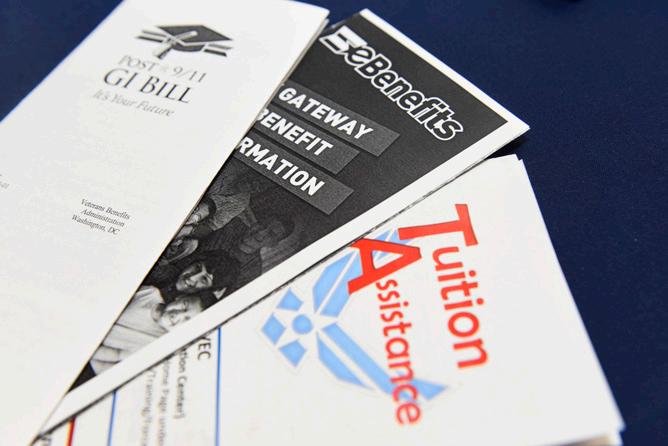

If a veteran has already obtained a private pilot’s license, they are able to use the Bill to gain supplemental qualifications including rotary wing, B747-400, Dual engine and flight engineer. Additional qualifications make getting the attention of major airlines that have a long history of hiring veterans, easier. The Bill will pay for the net costs of tuition at a college or university, or for training at a stand-alone pilot school, contingent on a yearly limit.

The real estate niche is an appealing career with brokers having a median average wage of $58,201 in 2018, plus BLS’s job outlook shows a steady increase over the coming years. While the Bill won’t pay for the actual licensing to become a real estate broker, it will fund the costs of test fees. In fact, getting reimbursed for test fees is applicable to all sorts of career choices ranging from veterinarian exams and adult nurse practitioner certifications, to pharmacist licensing exams.
Studying hard does not always provide the results one needs to achieve the final grade they want, and that is where tutoring comes in handy. While there are free resources likely available at colleges and universities, the Bill will pay $100 a month, up to $1,200, for a private tutor to help you succeed in whatever course you’re taking.
The Post-9/11 GI Bill allows students to think outside the box when considering a career outside the military. In addition to working toward a degree, beneficiaries can train for a specific career, trade, or industry – including vocational training or apprenticeships. Visit Education and Training to learn more about alternative investments for the Post-9/11 GI Bill
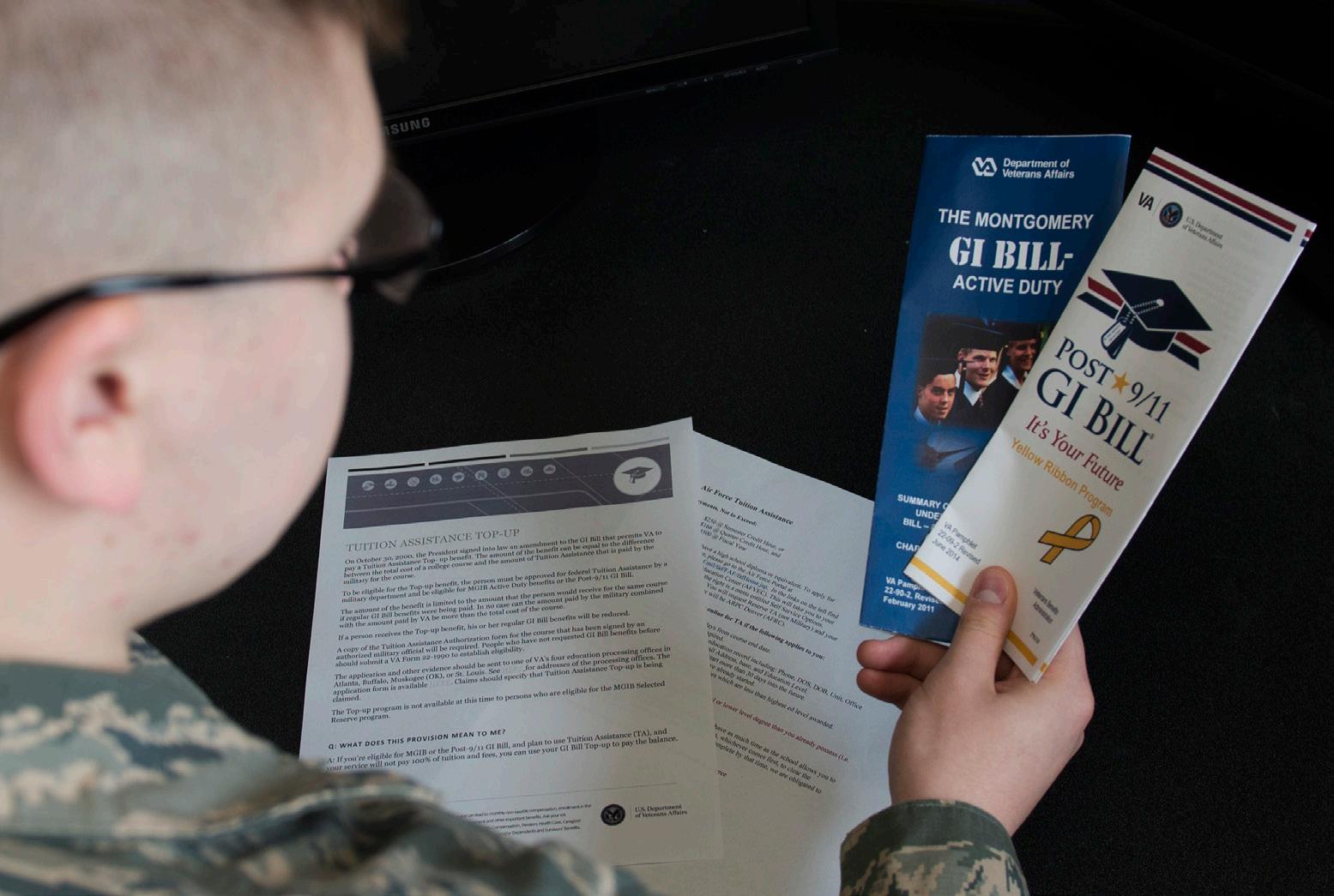
For those interested in being emergency medical technicians, the Bill is applicable to non-college certifications as well. According to the Bureau of Labor Statistics, employment of EMTs is projected to grow by 15% through to 2026, a much higher average than all other occupations. Therefore, the emergency medical setting is an attractive post-military career option for veterans. The certification, though, can cost upwards of $2,000, which makes the Bill’s help with tuition, books and supplies helpful during transition.
Efforts in the public and private sectors to recruit and employ veterans have contributed to a 3.8% unemployment rate for the more than 4 million veterans that served from 2001 to present, according to the U.S. Bureau of Labor and Statics. For the more than 19.2 million veterans over the age of 18, this is a positive employment forecast for life after the military.
Ted Avila, an employment specialist/disabled veteran outreach program specialist for the state of Hawaii, transitioned from the military six years ago.
“As military service members transition out of the military, they attend a transitioning seminar/ workshop. During this workshop they should be shown websites that address how to match specialty codes to civilian jobs for writing a resume,” he said.

Avila recommends veterans visit their American Job Center or Career Center where the veterans have priority of service and will be assisted with the development of resumes and cover letters specific to the job occupation/announcement. The AJC will also assist with job searches and matching military specialty codes. According to Avila, the most lucrative positions are in the technical fields.
“Veterans who have the education, certification(s) and/or licenses and experience will be considered by the employer,” he said. “Don’t forget veterans need to practice interviewing skills to ace the interview. The resume and cover letter only offer the opportunity to be invited for the interview. The interview itself will determine if the veteran meets the employer needs, and employers assess how the veteran will work within the organization.”
Many veterans will pursue employment in their military occupational specialty, according to Dr. Derek Abbey, interim director of the Joan and Art Barron Veterans Center at San Diego State University.
“Some of the most common interests are engineering, business, criminal justice, social work and health fields. The most lucrative in recent years have been the STEM fields, specifically engineering. Cyber security is growing rapidly and in demand,” he said. “A bachelor’s degree is very important and, in many industries, an advanced degree is needed. However, there are many fields where a bachelor’s degree is not needed. There are many technical fields that pay well. Some require things like a technical certificate or apprenticeships. Many of these fields are shorthanded in skilled workers to fill positions.”
Some fields that translate well from a service member’s career are:
• Engineering: BLS projects nearly 140,000 new engineering jobs from 2016 to 2026. In 2016, engineers had a median annual wage of $91,010, more than twice the median wage for all workers.
• Business and Finance: BLS projects business and finance to grow 10% from 2016 to 2026, faster than the average for all occupations, adding about 773,800 new jobs. The median annual wage for business and financial occupations was $68,350 in May 2018, which was higher than the median annual wage for all occupations of $38,640.
• STEM: BLS projects employment in science, technology, engineering and mathematics will grow to more than 9 million from 2012 to 2022. Although median wages vary, the median annual wage of architectural and engineering managers top out at over $128,000.
• Social Work: BLS projects social work and health service occupations to grow 16% from 2016 to 2026, much faster than
the average for all occupations. Employment growth will be driven by increased demand for healthcare and social services, but will vary by specialization. The median annual wage for social workers in May 2018 was $49,470.
• Cybersecurity: BLS projects cyber security occupations to grow 28% from 2016 to 2026, much faster than the average for all occupations. The median annual wage for cyber security operations was $98,350 in May 2018.
Education is another option for veterans. Yale University in New Haven, Connecticut, graduated five student-veterans in 2018. Three now work in finance, one attends Yale Law School and one is studying for his doctoral degree at Oxford University as a Gates-Cambridge Scholar. All of these students were members of Yale’s Eli Whitney Program, designed for individuals with high academic potential who have had their education interrupted, at some point during their educational careers, for five or more years.
Patricia Wei, director of Veterans Outreach in the Office of Undergraduate Admissions at Yale University, details opportunities available to veterans in higher education.
“These programs may aid veterans as they navigate their education after leaving the military,” Wei said.
• Yellow Ribbon: A scholarship program that allows approved institutions of higher learning and the VA to partially or fully fund tuition and fee expenses that exceed the established thresholds under the Post-9/11 GI Bill.
• Service to School: A program that provides free application counseling to military veterans.
• Warrior Scholars: A transition program consisting of a series of highly intensive, totally immersive, one and two-week college-preparatory academic boot camps hosted at America’s top colleges and universities.
San Diego State University and the Joan and Art Barron Veterans Center supports veterans through a variety of programs.
“We work with students to determine where they are at and where they want to strive for as a profession or education,” Abbey said. “Often SDSU is not the best fit for students, so we work with them on finding the best college or university for them.”
Abbey recognizes for many veterans transitioning to civilian employment is overwhelming. “We work with them to ensure they have the resources available to perform academically at the highest level possible,” he said.
Several resources exist to assist military-connected job seekers conduct searches geared toward specific military skills, including a tool from Google. Users can put “jobs for veterans” in the toolbar along with the MOS code: https://grow.google/ programs/veterans-commitment.

There’s a career fair happening somewhere near you. Fed up with the lack of results from your current job-search approach, you decide to go. At the career fair, you approach a booth, shake hands with the representative of the company and then have no idea what to say.

Is that scenario familiar?
Universally, this is a something many transitioning service members experience. Most often it’s because a job seeker doesn’t know how to sell their skills to recruitment managers at the career fair.
Hiring fairs, career fairs, networking events and other mixers are all ideal
opportunities to build relationships and grow your professional network. The challenge comes in being wellprepared and having a script of sorts to lean on when you’re standing at that hiring fair booth.
Jermaine Higgins is the vice president of operations and recruiting with Hire G.I., an organization that helps transitioning service members connect with employers who are actively seeking employees. Hire G.I. events average 200 attendees and about 35% of them receive offers for employment or offers to interview, so Higgins has seen it all.
He thinks it’s important that service members be realistic, respect
the time of the recruiter, and do their fair share of work before the event. Of equal importance is knowing if it’s a hiring fair or a job fair.
“A hiring fair offers a service member a platform for interviews on-site. This means they might walk away with a job. A job fair is generally used to network with recruiters and get insights into what will make you more competitive with the company,” said Higgins.
An often-overlooked aspect of attending is the registration process. Higgins says it’s the simplest way to prepare because it gives you real time updates about the event.
“When you register for the career fair, you get access to all communications from the host. You can usually upload your resume ahead of time so employers can review it — all before the event even starts,” he said.
R-E-S-P-E-C-T
First, respect the time of the person with whom you’re speaking. Have a polished and succinct “elevator pitch” on the ready for the company representative. At most, 10 sentences about how your path led you to stand before them will suffice. This is a first-glance opportunity for you to make a stellar impression. Make sure you can clearly identify what benefits
you’ll bring to any company.
“On average, most recruiters spend less than two minutes with each potential candidate,” noted Higgins.
That means you need a wellpolished and coherent elevator pitch. Practice selling yourself by succinctly and quickly explaining why you would make an excellent asset to any team. A fair gives you face time with a prospective employer and allows you to hone skills that you might be lacking.
Learning to speak civilian about the specific skills and traits you honed while in the military can be a challenge. View a fair for what it is and know that your first time out of the gate might not be your best. Be patient and realistic and work the skills. The more often you practice, the better you’ll become.
Determining your hard and soft skills and being able to eloquently speak about each is an asset that takes time to develop, but one that becomes invaluable the more it’s used, especially at a job fair. That way, when a hiring manager or corporate representative asks you to explain your work history, you have an answer at the ready.

Keep your expectations in check. View the experience just like an interview and challenge yourself to interview well.
“From my experience, many think that a job fair will get them a job on the spot,” said Higgins.
The reality is that hiring fairs are attended by hundreds of service members, so the best way to ensure you stand out is to make sure you offer the hiring manager a memorable experience.
“Look over the list of attending employers and decide which are your top contenders. Then visit their websites and do a deep dive into what the company does, what jobs are available, and what the culture is like,” said Higgins.
The better you understand the companies in attendance, the better chances you have of really connecting with a representative. This can easily segue into authentic and open communication with the hiring manager. Plus, it sets you aside from the rest of the applicants because it shows you put the time in to familiarize yourself with them.
A hiring fair allows you to network with other job seekers who are also seeking employment. This gives you the ability to measure how well you stack against the competition. You can also use fairs to grow your own network, since the stronger the unit, the stronger the individual is a truism both in and out of the military.
Of course, seeking employment is just like any other skill: it takes practice to perfect. With time, and the right amount of consistent exposure, you can improve your chances of landing a job that you really want.
Higgins also suggests that attendees do research about the companies which interest them most before attending.
 By Lizann Lightfoot
By Lizann Lightfoot
Veterans and military spouses are establishing small businesses at rapid rates. To succeed, these companies need a modern, long-term plan for growth and networking that spells success for veteran and military spouse entrepreneurs.
In today’s modern era, it is relatively easy to start a new venture online. In fact, a growing number of veterans are starting businesses while still in uniform, according to a report from the Center of Excellence for Veteran Entrepreneurship . At the same time, military spouses are turning to digital jobs that allow them to work from home and smoothly transition their business during Permanent Change of Station moves.
But what gives a startup the ability to last long-term and grow into a successful company? What new resources are available to veteran and military spouse small businesses, and what are the future trends of success for “milpreneurs?”
To answer such questions, two successful, military spouse business owners who have been helping other entrepreneurs grow their dreams share what they have learned. To many, their answers may be surprising and inspiring.
Lindsey Germono is the founder of Germono Advertising , a company that specializes in traditional and social media marketing for small businesses. While she has plenty of expert advice on social media tricks and strategies, Germono states that in person networking is still essential.
“I feel like we’ve glamorized remote businesses so much and people are attracted to running everything online, but good ol’ fashioned local networking really helps in building your business,” she said. “Make it a weekly goal to get out and network in person at local events and professional groups.”
Stephanie Brown, founder of The Rosie Network , also agrees that networking is essential to business growth, even if people mainly run
their company online.
“Nothing is more impactful on a small business than networking and great collaboration,” she said.
The Rosie Network strengthens military families through entrepreneurial programs and support services, ranging from Rosie’s List of milpreneur companies, training programs to local Rosie chapters.
Brown reported, “Collaboration happens all the time in our cohort groups; it has become the amazing natural byproduct of bringing folks together. Don’t limit yourself to military-only groups, either. Rosie has spent years developing relationships with civilian business and community leaders who donate their time and talent to our entrepreneurs.”
Modern businesses are attracted to social media in business marketing because of the low advertising costs and the potential to personally connect with customers around the world. While social media is an
excellent tool for small businesses, both Germono and Brown agree that social media should not overwhelm the long-term business strategy.
The Rosie Network encourages businesses to connect with local customers using traditional methods as well.
“Our military family-owned showcase events are often held at community events or big shopping malls,” Brown said. “They help bridge the gap between our small business owners and their communities.”
Germono reminds military entrepreneurs that social media should be just one piece of your business communication strategy.
“The very first step is to have a website, then you will use social media,” she said. “Not the other way around. You want to focus your social media strategy on driving people to your business! Don’t get hung up on likes and followers. Instead, focus on engaging with your target audience and pull those leads in.”
Small business owners want to stay ahead of the curve, constantly studying market trends and customer needs, while adapting to changing technology. There are several ways to keep a business strategy focused.
Germono encourages business owners to focus on professional development, no matter what degree or experience they have.
“There are a ton of programs and mentors out there that can help you with entrepreneurship, so take
advantage of as many programs as you can. Focus on accounting, finance, marketing, sales, and human resources.”
She also reminds entrepreneurs not to overlook the benefits of LinkedIn. It’s a platform where entrepreneurs can network, learn and find support all in one place.
“We are all here to help and if someone sees your request, they can share it in their feeds or make an introduction for you.”
Rosie’s founder says her company focuses on innovative ways to give military business owners the support they are asking for, “from our Military Entrepreneur sharedoffice incubators, Service2CEO training program, community showcase events, online Military Entrepreneur Magazine, Rosie Chapters and more.”
Its Military Entrepreneur Development Centers are a place where veterans or spouses can reserve a conference room, an office, schedule an appointment, use computers and printers or take monthly classes. The first MEDC opened in San Diego, California, five years ago, and the Rosie Network is now working to open new centers in Sacramento, California; San Antonio, Texas; and potentially on the East Coast. Brown explains that such shared workspaces aren’t just pretty offices.
“What sets us apart is that we offer a real, national awardwinning training program, called Service2CEO. Rosie Chapters are exclusively for our fellow military spouse entrepreneurs and also incorporate a version of Service2CEO.”
For veteran and military spouse
entrepreneurs, these strategies can help grow a successful business. Military entrepreneurs who run an online business should continue to attend in person networking events, and use social media as one of many ways to connect with customers.
Overall, focusing on professional development resources is an essential investment for a company’s future success.
Streetshares was founded by veterans with the purpose of bringing finance products to other small businesses. Their resources include business loans, lines of credit and account receivables financing for the government contracting community. According to its website, the company has helped provide over $100 million to U.S. Main Street businesses.
VettoCEO is a free training program offered to active duty military and veterans. Its online classes are offered in a collaborative environment that is available anywhere in the world. The Core Program is a seven week class that reviews business models, funding strategies and collaboration. It includes ongoing mentoring and support to help veterans start a successful business.
The game of Clue and Rosie the Riveter don’t usually have anything in common, but today they do. Two veteran entrepreneurs each took a seed of an idea and turned them both into successful businesses.
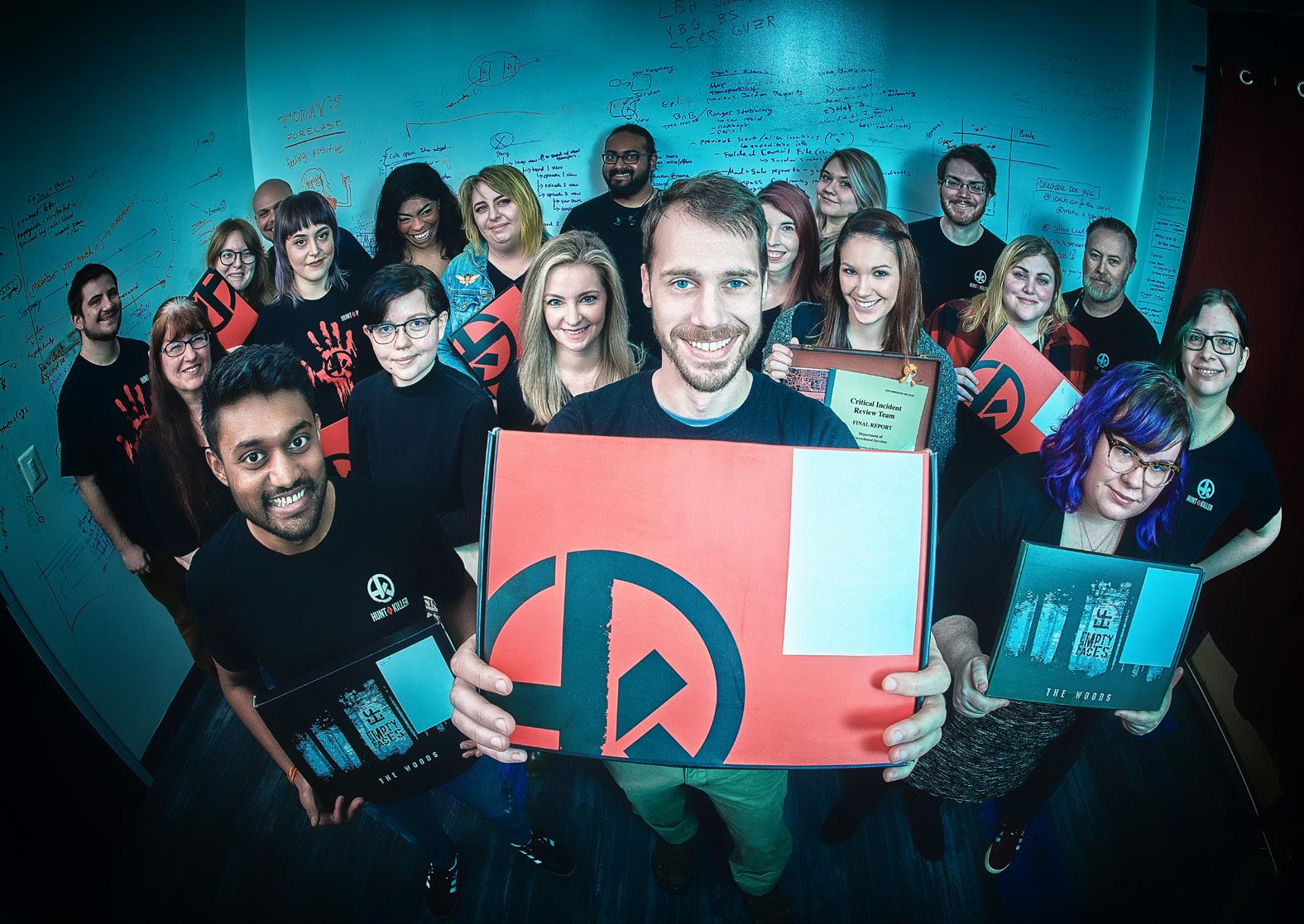
Navy reservist and 16-year active duty veteran Ryan Hogan is the co-founder of Hunt A Killer, what he calls “an immersive story that’s told episodically through a physical delivery.” Ultimately, he and his business partner, Derrick Smith, took what the public wanted and gave it to them: a love of interactive roleplaying, like escape rooms, and a need for monthly subscription boxes.
Jennifer Wakefield is the founder of Comrade Creative. When she left active duty Navy service and discovered a gap of veteran sisterhood, she aimed to fill it. The logo her company uses is an updated version of the World War II cultural icon.
“I just wanted to create a sisterhood of female veterans, that even after service we can still support each other,” Wakefield said. “We understand some of our same problems in transition, all while giving back to organizations that serve veterans, or if possible, specifically female veterans.”

Hogan and Wakefield’s success is, unfortunately, not the norm in America. During a panel discussion at the U.S. Chamber’s 75th Anniversary
of the GI Bill, Hon. Patrick Murphy — the 32nd Under Secretary of the Army — spoke about how most veteran entrepreneurs have to be prepared to fail, because most small businesses do in their first year. On the upside, though, he added that veteran entrepreneurs tend to be more successful than civilians.
Hogan knows all about failure, too. He is a serial entrepreneur who has started many businesses. In fact, 99% of them have fallen short. Hunt A Killer has found traction for success, but that came after a prior business shut down right before his transition from active duty.
“The biggest thing is there was always a fallback. There was always support,” Hogan said about being an active duty entrepreneur. Now, he does not have the guarantee of the Navy to keep him, his four children and his wife fed with a roof over their head.
“The other side to that is there are no guarantees … balancing adult responsibilities, balancing family
responsibilities and taking huge risks, that’s probably the biggest mental challenge here,” he said.
Wakefield had to use patience while her own business became established. While social media and word-of-mouth are beneficial tools to small business owners, the pace is not to be desired.
“It is hard to find a large audience
of female veterans to get the information out to in a quick way,” she said.
No matter the challenges, if people do what they love, the work becomes worthwhile. While Wakefield has a personal investment in uplifting specific niches within the veteran populace, Comrade Creatives is built upon a passion.
“I’ve had people that have been out for a decade or more, and they’re like, ‘For the first time I can support something that actually feels like it’s me.’ So that’s been amazing to actually give, ya know, proper recognition and representation to people that for so long didn’t have it,” she said.
By identifying a gap, Wakefield’s business venture, at the basis of it all, provided her with additional selfworth.
“So along with, ya know, sharing stories and building support around vets, being a peer support is something I really feel passionate about,” she said.
Hogan says his successes come from not only knowing what he is good at — finding product/market fit — but also identifying what others are good at.
“I think that there is this fallacy that lives where people think that they need to improve their weaknesses so they can be better in certain areas,” he said. “Well, that’s not how an entrepreneur should think. How an entrepreneur should think is if you have weaknesses, you should go find the best in the world at those things which will allow you to do what you are truly good at.”
At Hunt A Killer, Hogan and his
partner have built a team of over 40 people from all over the world. Each of them, he says, add value to his company that allow him to focus on aspects that he is an expert at.
When transitioning out of service, some may find it hard to identify how work skills can translate. But one thing that has helped Hogan’s entrepreneurial track — because he says his current success isn’t a result of one business, but a succession of many, even the failed ones — is the military’s mindset of not knowing how to fail.
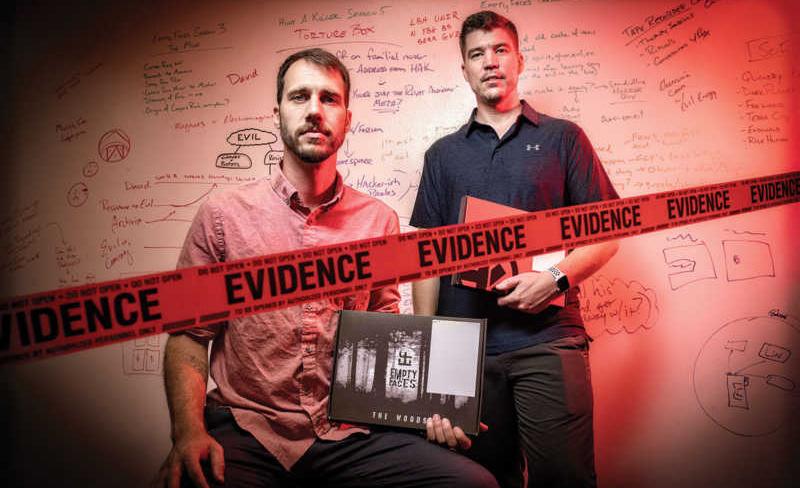
“You’re put through the stress test in the military constantly, and being able to translate a lot of that resiliency into business,” Hogan said. “I don’t think we talk about this often, or as often as we should, but the resiliency and being able to not understand failure, like, it gives us so much of an edge over 50, 60% of entrepreneurs out there who have no idea what they’re getting themselves into.”
The military’s structure and discipline has also helped Wakefield in operating her venture.
“You really have to be disciplined because there have been times, even for myself, that I had not anticipated, like, a rush of orders and it happened ... always set time aside, because even if you don’t have orders to fulfill or something to complete, you can still use that time to promote or build some type of new item or network.”
Neither Wakefield nor Hogan would be where they are today without actually taking the initiative to start. Many people have ideas, some not always successful, but Hogan says people have to take the first step for there even to be a chance at success.
“The biggest impediment for people is breaking that mindset that, ‘I can actually do this. I have this idea and all I need to do is figure it out.’ And so we know how to not give up, we know how to not stop,” Hogan said. “But I think sometimes we fall short on where to start.”
Learn more about Hogan and Wakefield’s businesses by visiting www.huntakiller.com and www.comradecreative.org
